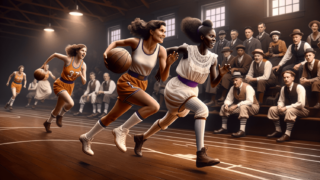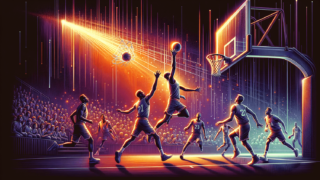
Welcome to a fun and informative exploration of the simple yet delightfully captivating topic – How to Spell Basketball? In this blog post, we will dive deep into the intricacies of spelling this beloved sport’s name, uncovering its etymology, linguistic nuances, and cultural significance. Embark on this linguistic journey with us, as we aim to enhance your appreciation for the word ‘basketball’ and transform your understanding of this seemingly straightforward subject. So, whether you’re a fanatical follower of the game, a casual enthusiast, or just intrigued by language, we’ve got you covered!
How to Spell Basketball?
Spelling basketball is quite straightforward: it is written as “basketball.” The word consists of two parts: “basket,” referring to the hoop and net in which points are scored, and “ball,” denoting the spherical object used to play the game. Altogether, this creates the compound word “basketball.”
Etymology of Basketball
Basketball is a term fused from the two noun components “basket” and “ball.” In English, the combination of distinct words to form a new, compound word is a common linguistic practice. Let’s begin our exploration by diving into the origins and development of each word.
The Origins of “Basket”
Derived from the Old French word “baschet,” which referred to a container made from woven material, the English word “basket” traces its roots back to the late 13th century. The term has since evolved and now more broadly encompasses any container or receptacle with a rigid frame made from various materials, like wicker, wood, or metal. In the context of basketball, the “basket” represents the hoop and net combo, which serves as the target for players to score points.
The Origins of “Ball”
On the other hand, the word “ball” originates from the Old English “beall,” a term employed to denote any round or spherical object. In the context of basketball, it symbolizes the spherical object utilized by players to pass, dribble, and score. As such, “ball” is an integral component of countless games and sports, with basketball being one among many.
Unveiling the Birth of Basketball
Now that we’ve delved into the etymology of the word “basketball,” it’s fitting to explore the inception and growth of this fan-favorite sport. Familiarizing ourselves with the birth of basketball provides valuable context for the composition of the word and the components it symbolizes.
Dr. James Naismith’s Vision
In December 1891, Dr. James Naismith, a Canadian physical education instructor based in Springfield, Massachusetts, came up with a new indoor game to keep his students active and occupied during the harsh winter months. He nailed a peach basket onto the gymnasium wall and asked his students to throw a soccer ball into it, thereby combining physical activity with vigorous competition. This innovative game soon evolved into the sport we know and love today: basketball. Naismith’s rules emphasized non-contact and encouraged skillful gameplay, principles that continue to define the sport.
The Evolution of Basketball Terminology
In the early days of basketball, players scored points by shooting the soccer ball into their opponents’ peach basket while preventing their opponents from doing the same. As the game evolved, so did the equipment and techniques employed. Consequently, the language and terminology surrounding basketball expanded to accommodate new components, rules, and playing styles.
The Basket: A Design Transformation
In basketball’s formative years, scoring involved throwing the ball into a peach basket. However, this design was far from practical. Each time a player scored, the game halted so that someone could retrieve the ball with a ladder or by poking it out of the basket with a long stick. By 1906, hoops with nets replaced peach baskets, allowing the ball to fall through more easily and significantly improving the flow of the game. Today’s baskets are constructed with metal rims and nylon nets, facilitating smooth gameplay and providing a visual cue for fans to follow the exciting action on the court.
Evolving Ball Technology
Initially, basketball utilized a soccer ball. Given its smaller size and lighter weight, the soccer ball was far from ideal since it lacked the grip and handling that today’s basketballs offer. In 1894, A.G. Spalding designed the first dedicated basketball, which featured a combination of leather panels and a rubber bladder. Throughout the years, the design continued to improve, incorporating a more durable rubber surface, better grip and handling capabilities, and the sport’s standard size and weight.
Definitive Guide to Basketball-Related Vocabulary
Beyond the simple spelling of “basketball,” an array of vocabulary and expressions accompany this dynamic sport. Explore some essentials below:
Key Components of Basketball
- Court: A rectangular playing area with specific dimensions, markings, and zones unique to the sport.
- Backboard: A rigid, rectangular structure mounted parallel to the baseline upon which the basket is mounted. The backboard plays a critical role in bank shots and provides stability to the basket.
- Rim: A 45-centimeter diameter metal circle connected to the backboard, to which the net attaches, forming the basket.
- Free Throw Line: A horizontal line on the court positioned 15 feet away from the backboard. This line serves as the designated shooting spot for free throws following a player’s foul.
- Three-Point Line: An arc-shaped boundary on the court that indicates the area from which a successful shot results in three points rather than the standard two.
Common Basketball Terms
- Dribbling: The act of bouncing the ball on the court as a player moves. Dribbling ensures that a player is not in violation of the traveling or double-dribble rule.
- Rebound: Gaining possession of the ball after a missed shot attempt. Both offensive and defensive players may obtain rebounds.
- Assist: A pass provided to a teammate that directly results in a successful shot attempt.
- Fast Break: A rapid transition from the defensive to the offensive end of the court, which capitalizes on the opposing team’s unpreparedness and results in scoring opportunities.
Dispelling Common Basketball Spelling Confusion
Despite the straightforward spelling of “basketball,” the compound word may still lead to common confusion and misconceptions. Here, we will address and clarify some frequent misunderstandings related to spelling and pronouncing the term.
Basket-Ball vs. Basketball
Although “basketball” currently exists as a compound word, early on, it could occasionally be found in a hyphenated form (“basket-ball”). This variation has since been deemed archaic, with the unhyphenated “basketball” becoming the universally recognized and preferred spelling.
Overcoming Pronunciation Challenges
While native English speakers might not have difficulty pronouncing “basketball,” those unfamiliar with the language might stumble over the word’s syllabic emphasis. A helpful tip involves breaking the word into two distinct parts: “bas-ket” and “ball,” then stressing the first syllable of each part to correctly pronounce “basketball.”
Armed with an enhanced understanding of spelling nuances, etymology, contextual background, and vocabulary, you are now set to delight in the multifaceted world of basketball. It is our hope that this in-depth exploration sparks a deeper appreciation for the sport’s origins and the linguistic journey that the word “basketball” has traversed to arrive at its current form.
Related Sports and Their Spellings
Understanding how to spell and pronounce “basketball” opens the door to exploring related sports and their spellings. By familiarizing yourself with these different sports, you can broaden your appreciation for athletic activities that showcase unique techniques, teamwork, and physical abilities.
Netball
Originating from early versions of women’s basketball, netball is a non-contact sport played on a rectangular court with raised goal rings at each end. Netball features seven players per team with specific positions and designated scoring areas. The correct spelling is “netball.”
Handball
A team sport played on a court, handball requires players to pass, catch, and shoot a ball into a goal in order to score points. Traditionally, the number of players is seven per team, with six outfield players and a goalkeeper. The word “handball” is formed similarly to “basketball,” combining the words “hand” and “ball.”
Volleyball
A popular sport consisting of two teams of six players each, volleyball is played on a rectangular court separated by a net. Teams aim to score points by grounding the ball in the opponents’ court. The term “volleyball” is formed by combining the words “volley” (to propel, as in a ball) and “ball.”
Futsal
Derived from soccer, futsal is a fast-paced, indoor sport usually played with five players per team, including a goalkeeper. While the court is smaller than a traditional soccer field, it emphasizes ball control, skill, and agility. The correct spelling is “futsal,” stemming from the Portuguese words “futebol” and “sala” (indoor).
The Influence of Basketball on Popular Culture
Basketball, a globally recognized sport, has taken its place in popular culture, influencing various aspects of society along the way. From films and music to fashion and language, basketball has generated a significant impact that reaches far beyond the court.
Basketball on the Big Screen
Over the years, basketball has provided inspiration to filmmakers, resulting in numerous movies that celebrate the sport, its importance in the community, and the resilience demonstrated by players striving towards success. Some noteworthy basketball films include “Space Jam,” “Hoosiers,” “Love & Basketball,” and “Coach Carter.”
Basketball and the Music Industry
Basketball has a long-standing connection with the music industry, especially hip-hop. Many prominent artists, like Jay-Z, Snoop Dogg, and Kanye West, have referenced the sport in their lyrics, drawing parallels between the game and their own experiences. Additionally, several professional basketball players have ventured into the music world, releasing albums and singles that showcase their creative talents off the court.
The Fashion of Basketball
Basketball has significantly influenced the world of fashion, with its signature jerseys, sneakers, and sportswear crossing over into everyday attire. The popularity of basketball shoes, like the iconic Air Jordan series, has fueled an entire subculture of sneaker enthusiasts, referred to as “sneakerheads.”
By learning how to spell “basketball” and immersing yourself in its diverse cultural impact, you not only strengthen your linguistic prowess but also gain unique insights into the sport’s extensive influence across various facets of society. This newfound appreciation can reinforce your love for the game and its myriad connections to the world beyond the court.
FAQ: Frequently Asked Questions
We understand that exploring basketball and its diverse connections may lead to some questions or curiosities. To assist you, we have compiled a list of common inquiries with insightful answers to enhance your knowledge and engagement with the subject.
1. Why was basketball invented?
Basketball was invented by Dr. James Naismith in December 1891 to provide his students with an indoor sport during the harsh winter months. The goal was to create a game that would help his students maintain physical fitness while also fostering team spirit and fair competition.
2. How has the sport of basketball evolved over the years?
Basketball has evolved significantly since its creation in 1891. Some key transformations include the elimination of the “jump-ball” after every basket scored, the introduction of the shot clock, advancements in ball and hoop technology, and the expansion of professional leagues like the NBA and WNBA.
3. How long is a basketball game?
A regulation basketball game typically lasts for 48 minutes, broken into four 12-minute quarters. However, this duration may vary depending on the level of play, with college and high-school games taking less time. Overtime periods are added if the game ends in a tie.
4. How many players are on a basketball team?
A basketball team generally comprises 12 to 15 players, with five players from each side on the court during gameplay. The other team members remain on the bench, ready to substitute as needed.
5. When did basketball become an Olympic sport?
Basketball was first introduced as an Olympic sport during the 1936 Summer Games in Berlin, Germany. Women’s basketball made its Olympic debut later, in the 1976 Summer Games held in Montreal, Canada.
6. What are some essential basketball skills to learn?
Some crucial basketball skills to develop include shooting, dribbling, passing, rebounding, and defense. Building proficiency in each of these areas can lead to a well-rounded player who can contribute effectively to their team.
7. What is the height of a regulation basketball hoop?
A regulation basketball hoop is set at a height of 10 feet (3.05 meters) above the court floor. This height remains consistent across all levels of play, from amateur to professional games.
8. What is a double-dribble in basketball?
A double-dribble occurs when a player, after initiating their dribble and picking up the ball with both hands, starts to dribble again. It is a violation in basketball, resulting in the opposing team gaining possession.
9. What is a traveling violation in basketball?
Traveling in basketball refers to a player taking more than two steps while holding the ball without dribbling. It is a violation, resulting in a turnover, and the opposing team gains possession of the ball.
10. What is the standard size and weight of a basketball?
For men’s basketball, the standard size is a Size 7 ball, with a circumference of 29.5 inches (74.9 cm) and a weight of approximately 22 ounces (624 grams). In women’s basketball, a smaller Size 6 ball is used, measuring 28.5 inches (72.4 cm) in circumference and weighing 20 ounces (567 grams).
11. What’s the difference between streetball and professional basketball?
Streetball, often played on public outdoor courts, is a more informal version of basketball that emphasizes individual expression, creative moves, and flashy plays. On the other hand, professional basketball adheres to strict rules and focuses on teamwork, organization, and overall strategy.
12. How can I improve my shooting accuracy in basketball?
Improving your shooting accuracy in basketball requires consistent practice, proper shooting form, and mental focus. Helpful tips include keeping your elbows straight, using a relaxed grip, and maintaining a balanced stance. It is also essential to use your legs for power and follow through with your shooting arm.
13. What was the first basketball team ever formed?
The first basketball team was created by Dr. James Naismith himself, consisting of his students at the International YMCA Training School in Springfield, Massachusetts. The team played the first-ever basketball game in history with nine players on each side, quickly leading to the formation of more teams and the establishment of the sport.
Featured Posts
- No pillar pages found.





